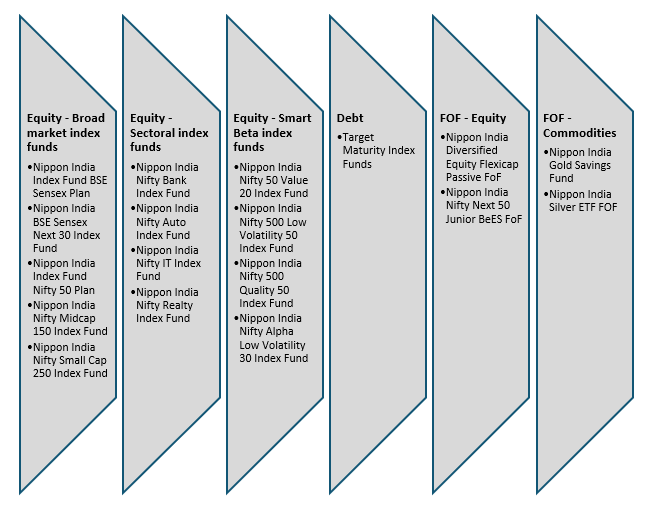Index Fund: SIP in Index Funds

Like developed markets, the importance of passive funds is increasing in India. In the last 5 years, the ratio of passive (ETFs and index funds) and active equity AUM grew from 31% in 2020 to 37% in 2025. While institutional investors prefer Exchange Traded Funds (ETFs), index funds are increasingly growing in popularity, as far as retail investors are concerned. In the last 5 years, assets under management in index funds multiplied nearly 25X (source: AMFI, as on 31st October 2025).
Why invest in index funds?
- Unlike actively managed funds, index funds have no unsystematic risks since index funds are not overweight / underweight any stock / sector relative to the benchmark index; index funds simply track the benchmark index.
- The total expense ratios (TERs) of index funds are significantly lower than actively managed funds. Unless active funds are able to generate sufficiently high alphas, the lower cost works to the advantage of index funds.
- There is no fund manager bias in index funds, since no judgement is involved in stock selection. Change in fund managers will have not have any impact on index fund performance.
- Unlike ETFs, you do not need to have demat accounts to invest in index funds. You can invest in index funds like any other mutual fund scheme.
- You can buy or redeem index funds at applicable Net Asset Values (NAVs) unlike ETFs. ETF transactions take place at prevailing market (bid / offer) prices which may be at premium or discount to Net Asset Values (NAVs) of the ETFs.
- In extreme market conditions, you may not find sufficient buyers for your ETF units in the stock exchange or may be forced to sell your ETF units at considerable discounts to NAVs. On the other hand, you can redeem your index fund units with the asset management company (AMC) at applicable NAVs).
- You can accumulate units of index funds through your monthly savings using Systematic Investment Plan (SIP); SIP facility is not available for ETFs. Through SIP you can accumulate index fund units over long investment horizon and create wealth through power of compounding.
In this article, we will discuss about SIPs in index funds, with particular reference to passive schemes of Nippon India MF. Nippon India MF as an AMC, has the longest track record in passive space (with the first ETF and also the first commodity ETF to be launched in India).
Nippon India MF also has one of the largest and most varied product offerings in the mutual fund industry, as far as passive products are concerned. Nippon India MF passive products covers all asset classes e.g. equity, debt, commodities etc. In this article, we will cover the range of index funds and passive FOFs of Nippon India MF. We will also discuss SIPs in Nippon India MF index funds and passive FOFs, which can be just as effective in wealth creation as active diversified equity mutual funds.
Range of Nippon India MF index funds and passive FOF offerings
Nippon India MF's index funds and passive FOFs can be broadly divided into 5 sub-categories based on asset class and investment strategy:-
- Broad market index funds (equity) - Index funds tracking indices representing the broad market or market segments e.g. Sensex, Nifty, Nifty Midcap 150 etc.
- Sectoral index funds (equity) - Index funds tracking indices representing industry sectors e.g. Bank, IT etc.
- Smart Beta index funds (equity) - Index funds tracking factor indices representing industry sectors e.g. Bank, IT etc.
- Target maturity index funds (debt) - Index funds investing in debt instruments with a target maturity date
- FOFs - Equity - Fund of Funds investing in equity ETFs
- FOFs - Commodities e.g. gold, silver - Fund of Funds investing in commodity ETFs
Index funds and passive FOFs offer a wide range of investment solutions for investors with different risk appetites and investment needs.

SIPs in index funds
Mutual SIPs as a way of investing has started to rival traditional ways of investing in India. In the month of October 2025, total amount invested through SIP was Rs 29,529 crores, up almost Rs 4,000 crores on a year on year basis (source: AMFI, October 2025). Just like SIPs in active diversified equity funds, you can also invest in index funds through SIP. By investing through SIP, you can start early with relatively small amounts and accumulated wealth through the power of compounding (see the table below). SIPs also take advantage of market volatility to average out your purchase cost (Rupee Cost Averaging). Rupee cost averaging can boost your wealth creation by acquiring units at a lower cost in phases of market correction.
The table below shows the growth of Rs 10,000 monthly SIP in different Nippon India MF index funds (excluding Target Maturity Funds) and passive FOFs. You can see that over longer investment tenures (5 - 10 years plus), you could have accumulated significant corpus by investing through SIPs in these Nippon India MF index funds or FOFs. Please note that in this table, we have shown SIP returns of schemes that have completed minimum 3 years for purpose of illustration. However, you can invest in any Nippon India MF index funds or FOFs based on your risk appetite or investment needs.

Source: Advisorkhoj Research, as on 31st October 2025
Taxation of index funds and passive FOFs

Who should invest in Nippon India MF Index Fund SIPs?
- Investors seeking wealth creation over long investment horizon.
- Investors who want to invest in passive schemes to eliminate unsystematic risks and lower costs.
- Investors who want to invest for their long-term financial goals like retirement planning, children's education, children's wedding, wealth creation etc, from the regular savings.
- Investors with high to very high-risk appetites.
- Investors with minimum 5-year investment tenures.
Investors should consult with their financial advisors or mutual fund distributors which Nippon India index funds may be suitable for their risk appetites and investment needs.
Mutual Fund Investments are subject to market risk, read all scheme related documents carefully.
RECOMMENDED READS
The information being provided under this section 'Investor Education' is for the sole purpose of creating awareness about Mutual Funds and for their understanding, in general. The views being expressed only constitute opinions and therefore cannot be considered as guidelines, recommendations or as a professional guide for the readers. Before making any investments, the readers are advised to seek independent professional advice, verify the contents in order to arrive at an informed investment decision.
Mutual Fund investments are subject to market risks, read all scheme related documents carefully.
Quick Links
Follow Nippon India MF
More About Nippon India MF
POST A QUERY






